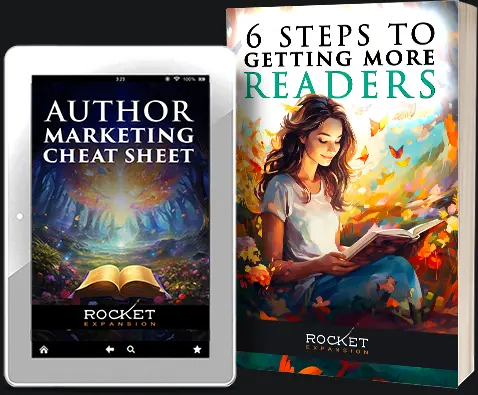Beginners Guide: How to Self-Publish A Book (5 Easy Steps)

Your book is doomed.
No one will ever read it.
No publisher would touch this with a ten-foot pole.
Either an agent, publisher, or the negative voice inside your head has said something similar to you. But the truth is simple. You’re the one who decides the fate of your book.
Choosing to self-publish a book is choosing the freedom to chart your own course. But it’s not as scary as it sounds. To ensure you’re equipped with enough knowledge to get started, we’re breaking down the must-knows about self-publishing a book.
Whether you’re a seasoned author, or a writer ready to dip their toe into the publishing pool, we’ve got the information you’ll need.
Note: Amazon is the most popular book sales option so we’ll refer to their services more often than others in this blog.
How is Self-Publishing Different?
If you’ve ever tried to get a book traditionally published, you’ll understand how helpless one can feel. No matter how hard you try, it feels like you hold none of the power and you’re not in control.
Self-publishing turns the tables to give you the power and control to publish your own book. Let’s paint a quick, side-by-side picture of how each differs.
| Traditionally publishing a book | Self-publishing a book |
|---|---|
| You’re handing over all the complicated tasks of designing the book cover, figuring out where to distribute the book as well as printing it. | You’re taking on all of those tasks for yourself to complete. You manage the design, distribution, printing, and marketing. |
| They focus on making sure each phase is done to a high quality while you write the sequel or promote it on social media (and let’s be honest, some publishers help out with that sort of marketing too). | YOU have to focus on making sure each phase is done to a high quality and you have the burden of the costs. |
Self-publishing a book doesn’t make you a lone ranger. There are plenty of services and freelancers who can help you cross the line! We’ll go into more detail on those further down.
Benefits of self-publishing a book
Learning how to publish a book can be intimidating for any new author (and experienced authors too!), but going this route comes with many upsides:
- No more waiting by the phone: You don’t have to cross your fingers and toes hoping someone will take a chance on your work.
- Fewer barriers: Publishers and literary agents don’t determine whether your book is published or not.
- In control: You have a say in how each step of the process goes.
- The same but different: Indie books can look just as good as traditionally published books due to the improvements in quality in the self-publishing world.
- No cuts, no buts, no coconuts: You don’t have to share a large chunk of your revenue with publishers and agents (you may have to share a percentage with some services but nothing gets done for free!)
The Different Ways to Self-Publish a Book
Just like there are many publishing houses to choose from, there are different methods for self-publishing a book. Below is a high-level view of how each works:
- Vanity Press: They agree to publish your book, charge for services upfront, and outsource to the lowest bidder. This works if you’re not planning on making much money and you want to make a book for a select audience like family and friends.
- Hybrid publishing: They handle the publication process for you but you foot the bill. The prices and quality of work can vary so do your research before signing any contracts.
- Truly DIY: This is the recommended route. You vet the service providers for different steps of the publication process and make every decision, i.e. who distributes your book, how your book cover will look, who edits your manuscript, etc.
Examples of Self Publishing Services
If you’ve decided to go with the recommended method, you can use one of the below services to print and self-publish your book:
- Amazon KDP (Amazon distribution only)
- Draft2Digital
- IngramSpark
- Lulu
- Barns & Noble Press (US only and B&N distribution only)
- Kobo books (eBooks only)
- Google Play (eBooks only)
- Apple Books (eBooks only)
Note: You can use a mixture of these services to distribute your book. Publishing on one does not make the book exclusive to that platform, and you can copyright it to avoid any possible issues. However, if you sign up for Amazon KDP Select, it gives Amazon exclusivity on your eBook.
Print on Demand (POD) vs Offset Printing
Assuming you don’t plan to publish eBooks only, you’ll need to print paperbacks, and in some cases hardcovers. There are 2 methods you can go about for printing:
- Print on Demand (POD): The distributor prints one book at a time when an order is made and only takes a percentage of sales made. Which means there are no upfront costs.
- Offset printing: You print 1000 copies minimum, arrange for storage, and wait for orders to send them out. This incurs upfront costs but you’ll have lower unit costs.
A lot of authors who publish their own books go with POD because the alternative requires you to have storage space for these copies which will incur warehouse costs. Plus, bookstores rarely stock indie authors unless there is demand in that area for them.
However, if you have a deal with some local bookstore to stock your books then by all means go for offset printing. Do what works for you, just remember that it will take a lot of groundwork on your end to make this route worthwhile.
Considerations For Self-Publishing a Book
Before going any further, how you self-publish your book will depend on the following factors:
- Budget: How much money can you allocate to processes like editing, book cover design, marketing, printing, etc.?
- Skillset: Do you have any skillsets that you can use to make this process easier, like a background in design for your book cover, or a platform for marketing and gaining beta readers, etc?
- Distribution plan (ebook or print or both): Are you willing to invest your time and money in publishing in both formats or just eBook?
Having these considerations in the back of your mind will help you start forming a legitimate plan for self-publishing your book.
How to Self-Publish: Step-By-Step Process
We’re going to look at the different steps to self-publishing a book that any beginner or experienced author can grasp easily.
Follow these steps to publishing a book:
- Have something worth self-publishing
- Don’t skip the editing
- Design an attention-grabbing book
- Get ready to publish
- Put your marketing plan together in the beginning
Have something worth self-publishing
It’s the obvious first step but it needs to be mentioned: write a book readers want to read.
Imagine being in the process of self-publishing a book and wondering if you did your best with writing it. The aim is to do everything possible to give your book the attention it deserves.
Because a poorly written book means bad reviews, which will dissuade others from buying it. All of your hard work can’t be for nothing.
To give your book the best chance at succeeding, we suggest you conduct some market research so you have all the information you need as an author beginning their business. Because self-publishing will become your business.
Research the following:
- Learn from the Best-sellers (and competition): Look at what works for those books’ story, marketing, promotion, etc. to learn how to apply that to your own strategies for writing and marketing down the line.
- Minding the gap: Does a sub-genre need to make a comeback? Will certain tropes grab readers’ attention more than others? Fill the gaps in the industry that only you’re capable of doing!
- Listen to what the readers really want: Go on forums like Reddit, TikTok, the review sections on Amazon and Goodreads, etc. to see what readers like and dislike.
Another way to improve your chances of writing a good book is to talk to other indie authors and writers. You can find groups on Instagram, Twitter, Reddit, Facebook, or through workshops. Also, check with bookstores and libraries in your area if they know of any local writing groups.
A writer community can be beneficial to seeing what’s happening right now, and learning from other’s experiences. But it can also help you stay motivated to keep to your goals and get better at writing.
The better you can convey your book’s story, the easier it will be to read and gain fans.
Don’t skip the editing
Even if you’re fantastic at editing your own work, you need to invest in editing if you want your book to look as professional as traditionally published books.
Editing can set amateurs apart from professionals.
Note: Before handing your manuscript over to a professional, do your own round of edits to save them time over issues you can resolve. Check for spelling, grammar, and plot development. Place yourself in the shoes of your target audience and see if you’re happy with how the characters and story progress.
You are one person, you won’t see everything that can be improved in your manuscript. Here are the different types of editing you can hire editors for:
- Manuscript Review: The editor will look at your plot, character development, structure, and narration of your story to ensure on a high level that your manuscript is solid.
- Line editing: An editor goes line by line to address the language used and correct the structure of your sentences. The aim is to convey your plot as simply as possible.
- Copy editing: Spelling and grammar, as well as any inconsistencies with tone, will be sorted out in this round of edits.
- Proofreading: This is the last round of edits, done after typesetting, that will address errors with page breaks, typos, or any other small issues. After proofreading, your manuscript is ready to be printed.
You’ll likely pay for each round of editing separately, and freelance editors may charge around $30-$60 per hour.
Conduct sufficient research to find the best fit for you (that has some sort of qualification and experience), or it will be a waste of time and money.
Top Tip #1: You can enlist beta readers to review your book for free before you send it to paid editors. They outline issues with the story, characters, pacing, tone, etc.
You can find freelance editors on:
Top Tip #2: When picking an editor, make sure to get quotes from different people and have a discussion to understand their experience and expertise. For example, if you write romance in the third person and the editor only ever works on self-help books written in the first person, they’re not the one for you.
Design an attention-grabbing book
First, let’s talk about the internal – which is not technically supposed to be attention-grabbing but functional. We’re talking about book formatting.
Without attention to detail and following the rules of formatting, your book will be difficult to read. And it’ll look unprofessional.
A book that has the wrong type of font, bad spacing, and too many empty spaces will have the reader wondering how your book landed on the bookshelf.
Besides formatting, you also need to ensure your book has the following composition:
- Front matter: The title, copyright, dedication pages, etc.
- Body matter: The chapter title and body pages.
- Back matter: The author bio, bibliography, and index pages.
Book cover design
For a lot of readers, they’re looking for love at first sight connection with their next book. You need to make sure your book is the one.
Coming up with a book cover idea that stands out is paramount to your book sales. A poor profile on a dating site won’t get a lot of clicks right?
Follow these tips for creating a good book cover that will compel readers to pick your book up:
- All about the Genre: Your book should look like it belongs next to other books in its genre on the bookshelf. Use fonts, colors, and imagery that are synonymous with your genre.
- It’s not stealing, it’s inspiration: Look at what other successful books are doing and try to replicate that in your own way. Take note of where the Title and author name are positioned, what is the focal point, and what makes it pop.
- Take a step back: Your book cover needs to be as effective as regardless of the size, for example, when it is a thumbnail on Amazon, readers should still be able to identify what’s on the cover.
- It matters in Black and White: For eBooks, you have to account for how it will look on different devices, so make sure your book looks good in grayscale as well as low quality.
If you think you have enough knowledge about design to do it on your own, we suggest the following software for creating your book cover:
- Canva: A free, beginner-friendly software that has limited features but is great for creating promotional images too.
- GIMP: Another free option, with great plugins but it’s not as easy to use or figure out for beginners.
- Photoshop: Paid option that takes a bit of practice and learning but is not that hard to use.
But there’s no shame in hiring a professional!
Creating a book cover is not easy, considering it’s the first impression your book makes on a reader. You can look on Fiverr, Upwork, Reedsy, and 99Designs for professional book cover designers.
Be sure to do your research on their experience and previous works!
Back of a book
The book cover pulls the reader in, and the back cover of your book entices them to open your book and start reading. Your back cover should include:
- A tagline: A bold one-liner that ramps up intrigue.
- Book Blurb: A spoiler-free description that tells the reader what the book is about without summarizing the plot.
- Book Reviews: Reviews from authoritative figures (publications, other authors, etc.) can convince readers that your book is good without them reading it yet.
- Awards and Past Work: Include any accolades you’ve received that add credibility to your book.
- Author Bio: Share your credentials, writer’s journey, other works, etc. where applicable (your readers don’t need to know about your noisy husky at home).
- ISBN and barcode: Your book’s ISBN (International Standard Book Number) is a number that is used to identify your book. The accompanying barcode is the scannable version of this number.
Top Tip #3: You can either get a free ISBN from certain platforms like Amazon, but you can also purchase different ones for other versions of your book like hardcovers, paperback, and eBooks. And if you want to sell your book in local bookstores, you’ll need a barcode.
Note: Don’t neglect the spine of your book for print copies. The author’s name and book title should be easy to read and be in tune with the rest of the cover.
Get ready to publish
Welcome to the final stretch of self-publishing a book. There’s a lot of admin and decision-making left; these last steps may really feel like a stretch.
Book metadata
You need to get your book metadata together to fill in details when publishing your own book in eBook and print format. You don’t want to open up a form to publish your book and be coming up with details on the fly.
This information will also come in handy when sending ARCs and book press releases for book promotion.
Examples of metadata are:
- Book Title
- Book Blurb
- Author name
- Price
- Publication date
Book title
Choose a title that will intrigue readers while giving them a sense of what it’s about. Also, consider subtitles if they will add understanding to your book’s topic.
Here’s an example of a subtitle: The War of Art: Break Through the Blocks and Win Your Inner Creative Battles.
Your book title needs to be easy to remember for readers as well as original. There are no copyrights on Book titles so you can pick one that exists. However, naming your book something like Hunger Games will not do it any favors.
Top Tip #4: Do a quick Google search to see what comes up when you type in your book title to see if your book will be found easily on the internet.
Book blurb
A 100–200-word marketing copy that describes what your book is about in a way that captivates readers. It’s placed on your book and your Amazon Book Page.
Consider why readers would love to read your book and feature that. Because you’re self-publishing your book, you’re in charge of market research. Browse forums and see what they say about books they love and incorporate that type of language into your description.
Top Tip #5: Use keywords that are common in your genre to help your book’s online presence and set off alarm bells in readers’ heads that this book is for them.
Author name
Karin Slaughter works great for horror but would be strange for chick-lit books. Decide whether you’d like to use a pseudonym or your real name as your author name.
If you plan to write in different genres, you can use pen names for each genre.
Or if you know you’re destined to write one genre, and your name is nice enough for that genre, you can stick to your name, Stephen King.
Book Price
The price of your book should be in line with the market, meaning it should be similar to your competition’s pricing.
Top Tip #6: Look at other self-published novels and not traditionally published books for similar book prices.
You can price it higher if you feel confident enough fans will buy it. But if you’d like to grow your reader base, a lower price can onboard some soon-to-be fans to build your community.
Note: When it comes to eBook retailers like Amazon, your cut of the sales depends on your pricing. Amazon KDP is the most varying in price, giving you a smaller cut if you price below $2.99 or higher than $9.99. Use this to inform your book price.
Publication date
Consider your book marketing efforts and the timeline required. We’d recommend you give yourself 1-3 months of book launch promotion leading up to the release (we’ll go over marketing further below).
Also, note if your book can take advantage of a holiday release. For example, a Christmas romance launching in December would be perfect to get readers in the festive mood.
Distribution
When deciding which platforms you’d like to publish your book on, choose the distributor that accommodates your needs.
Follow their guidelines for formatting and uploading your book cover, manuscript, and book metadata then click publish!
They’ll review your submission and let you know once it’s approved.
Put your marketing plan together at the beginning
Understanding how to self-publish your book is about more than just publishing. If you want your book to rake in sales, you need to invest a significant amount of time in book promotion.
We’ve listed this last, but in reality, it needs to be considered from the first step of your self-publishing journey. Here’s a list of marketing ideas you can implement:
Author website
Every serious author has one! It’s your 24/7 online presence for industry professionals and readers to engage with.
You can use it to connect with readers, house your blog, promote your books and events, display your other works like podcasts and other services, etc.
An author website is essential for your longevity as an author if you want to build up a loyal community that buys all your upcoming books.
Luckily for you, this is what we do best! We’re specialists in creating beautiful, functional, and engaging websites for authors. Check out our author website design services page to learn more and inquire.
Author newsletter
Did you know you can communicate directly with interested readers and hold their attention? This is possible with an author newsletter.
You can achieve this by having a reader magnet on your website that entices target readers to join your mailing list. From there, send really good content that warms them up to you, making them more likely to buy your books or any of your other services.
Many authors use this platform because sending emails to readers regularly gives you high retention and engagement with your target readers over a long period.
It’s a sustainable way to engage with your reader base.
Blogging
Another way to provide your readers with content is via a blog– which will also fit well on your author website.
Blogs help make you more visible on Google when write about frequently searched keywords. By going for keywords your target readers search for, you’re more likely to show up on their radar.
And writing simply from the heart, without an angle on a specific topic, is still rewarding for fans who just want to hear what you have to say.
Book blog tour
A book blog tour is exactly what it sounds like.
Instead of touring different bookstores and venues, you tour book bloggers’ platforms.
Find book bloggers that overlap with your ideal reader and ask if you can write about your book as part of your tour. This helps you reach a larger audience, and you can funnel them to your own website with referral links.
Social media engagement
Everyone is on social media, including your future fans!
Find the social media platform they regularly visit and start posting curated content to pique their interest.
You can promote your books by sharing milestones in your writing journey, posting book teasers, and even collaborating with book influencers to spread the news about your book release.
Speaking engagements
If you’re a speaker as well as an author, you can use speaking engagements to spread the word about your book.
You can have a talk on your book’s topic, and bring your books along to be sold afterward. Or you can book more speaking engagements leading up to your book’s release to build hype.
Book signing
Holding a book signing is a great way to meet readers and turn them into fans, or to reward fans with a personal signature from their favorite author!
As a newer author you may have a hard time selling out venues, but even having a reading and Q&A at your local bookstores will drum up a few new readers you wouldn’t have otherwise.
Book reviews
A review says, “I loved it, and here’s why you might love it too!”
Use professional book review services to get polished reviews that can be placed on your Amazon book page, your author website, the front of your book cover, and as a tagline in Facebook ads.
If your budget isn’t flexible enough for that, you can also get a launch team together to read your book and post reviews on Amazon and Goodreads when the book launches to help it gain traction with the algorithm.
Top Tip #7: Print ARCs (Advanced Reader Copies) to share with those you’d like to get endorsements from, including your launch team and professional book review services.
Book trailer
Movies shouldn’t get to have all the fun.
Book trailers add another dimension to your marketing to help readers understand what your book is about while creating buzz around its release.
It’s more effort than just posting pictures of your book cover online, but video is the format that grabs many people’s attention nowadays – so use it to your advantage!
Book launch
Who doesn’t love a good party?
A book launch is a great way to celebrate your new release and promote your book at the same time. You’ll have fun activities like giveaways, Q&A’s, etc. and you’ll get to connect with readers who can’t wait to read it.
Plus, you deserve to celebrate that you’ve finally launched your book!
Check out our blog How To Promote Your Self-Published Book for insights and tips.
A Few More Self-Publishing Tips
One blog isn’t enough to answer the question: how do you publish a book? But we wanted to squeeze in a few more tips to help you out:
- Know that what works for other self-publishing authors, may not work for you.
- Join workshops and courses to learn more about self-publishing.
- Expensive services don’t mean high quality and cheaper services don’t mean low quality – do your research!
- You can hire an editor for your book blurb and author bio to ensure it looks up to standard.
- Let your book go through a few rounds of edits to make sure all errors are caught- but there is a thing such as too much editing!
- Edit your book cover just as much as your manuscript to land on the most polished version you can.
- Run your book cover by a few other people who can give you important feedback.
- Your first book in the series can be a lower price, increasing as the series goes on.
- Send ARC copies to bookstores to ask them to stock your book.
- Build connections with bookstores and other retailers to gain insight into what they look for when stocking self-published books.
- If you own your books’ ISBN you can register as your book’s publisher, making it simple to publish on different platforms.
Just Keep Going
Authors who may not have otherwise had the chance, are now able to get their work out into the world because self-publishing a book is easier than it’s ever been.
With that being said, it’s not going to be a stroll in the park. No matter how much information you research, there will always be lessons to learn as an indie author – even after you’ve self-published multiple novels.
And we’re here to make one step of the journey a little easier – your author website!
We’ve built stunning websites for best-sellers and indie authors, and we’d love to build yours. When you’re ready to take that bold step online, fill in this inquiry form so we can help you create an amazing website that reflects you and your books.

Want help with your author marketing? Get our FREE ebook and cheat sheet: 6 Steps To Getting More Readers.
By subscribing, you agree to get emails from me, Matt Ziranek. I’ll respect your privacy and you can unsubscribe any time.






